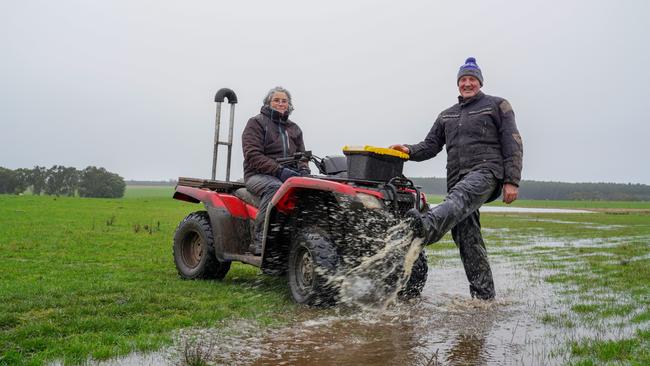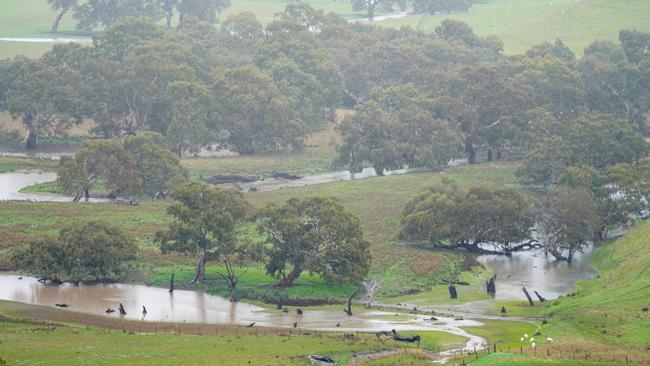Victoria rain: Record falls dampen lambing hopes and drown crops in south west
Some of the wettest conditions in the past 40 years have south west farmers battling mud. We look at the impacts on farm.

It’s a case of too much of a good thing when the rain tumbles down in July across much of southern Australia, leading to tough lambing conditions and some drowned crops.
But farmers such as Geoff and Barb Botterill, who farm at Digby near the South Australian border with their sons David and Thomas, are thankful to see the landscape replenished with water.
The Botterills have had some of the wettest weather recorded since the early 1980s.
During the past month their farm received around 170mm of rain.
This had caused a few headaches for lambing ewes, Mr Botterill said.
Although ewes were provided with plenty of shelter, regrettably the harsh weather led to “a few lost lambs”.
“It does knock the growth rates back a bit too,” he said.
The Botterills also have crops at Tahara, on heavier country, which were “managing fine at this stage, it is just the access to put urea out is an issue”.
Ms Botterill said the rain was welcomed overall, filling dams and replenishing the environment, “giving creeks a good flush of water”.
“Absolutely it is good to see the rain, its fantastic, although of course winter rain sets us up it is no guarantee of good spring rain when it is most-needed.”

According to the Bureau of Meteorology rainfall records were broken at several Western District locations in the past month.
It was the wettest July on record at Portland and Cape Nelson in the state’s far west, and south of Hamilton, it was the wettest July since 1978 at Penshurst and since 1981 at Branxholme.
And, Coleraine also recorded its highest daily rainfall of 41mm, the most received in one day in 67 years.
The wet July conditions have lowered farmer’s expectations of their lambing percentages come marking time, across many southern regions.
Meridian farm consultant and Casterton farmer Andrew Speirs said conditions were particularly tough when rainy weather continued for days on end, failing to give the stock and paddocks a chance to dry out, and warm up.
“Days on end like that, which we have seen this month, increase the wind chill factor and risk of lamb losses,” Mr Speirs said.
“Three days in a row (of rain) can wear down an animal’s energy reserves.
“For lambs born in that period, it can lead to a lambing percentage (survivability) decrease of 10-15 per cent in that window, for lambs three to four days old and then they become a lot more resilient“.
Lamb birth weight had a big bearing on lamb survivability, or the lamb’s ability to weather the cold conditions, as well as the suitability of the paddocks the ewe lambed down in.
Paddocks with ample feed helped lambing ewes by preventing the mothers from moving away from young lambs to feed, reducing the risk of mismothering or lost lambs, he said.
Another way farmers could limit losses was to chose the best paddocks for lambing and for paddocks lacking feed, provide supplementary lick feeders to boost ewe’s energy levels.
For cropping farmers, many crops in the state’s south west were looking rather soggy.
Mr Speirs said some crops were waterlogged and lacking oxygen in the soil in the Ararat, Ballarat and Lake Bolac regions.
“Most of the crops will be OK, as long as it dries out a bit,” he said.
“There will be some later sown crops that will be a write-off.
“Those on beds or contour drains will be doing OK, but it does depend on what further rain comes.”
In the Lake Bolac district, Gorst Rural farm supplies director Cam Conboy said the main issue facing growers was “getting on the country to apply fertiliser or spray for weeds or diseases”.
The risk of waterlogging was also on the minds of growers but Mr Conboy said most crops were “holding on really well given how wet it is”.
“It all just depends on how long it stays this wet for.”
MORE


